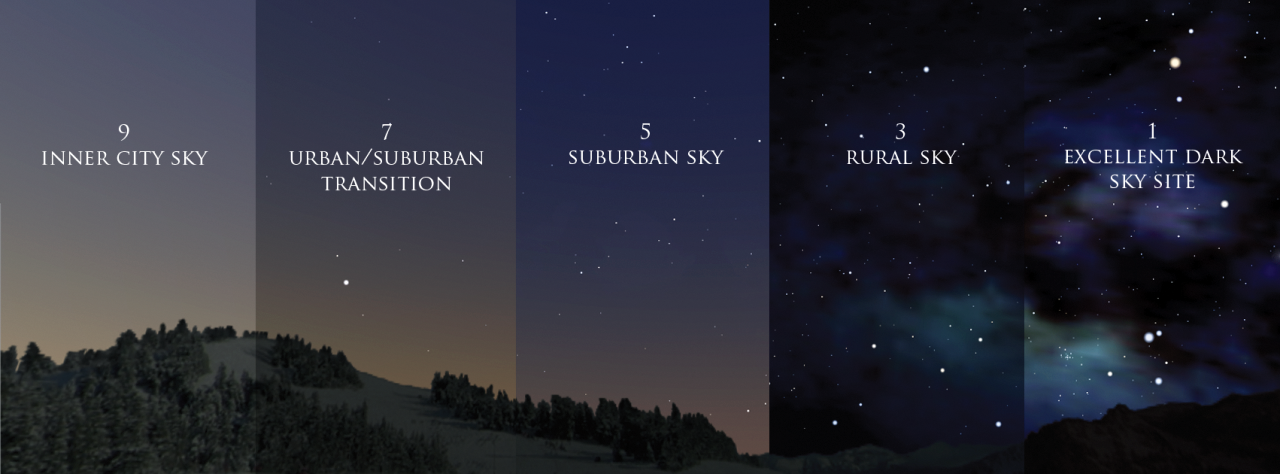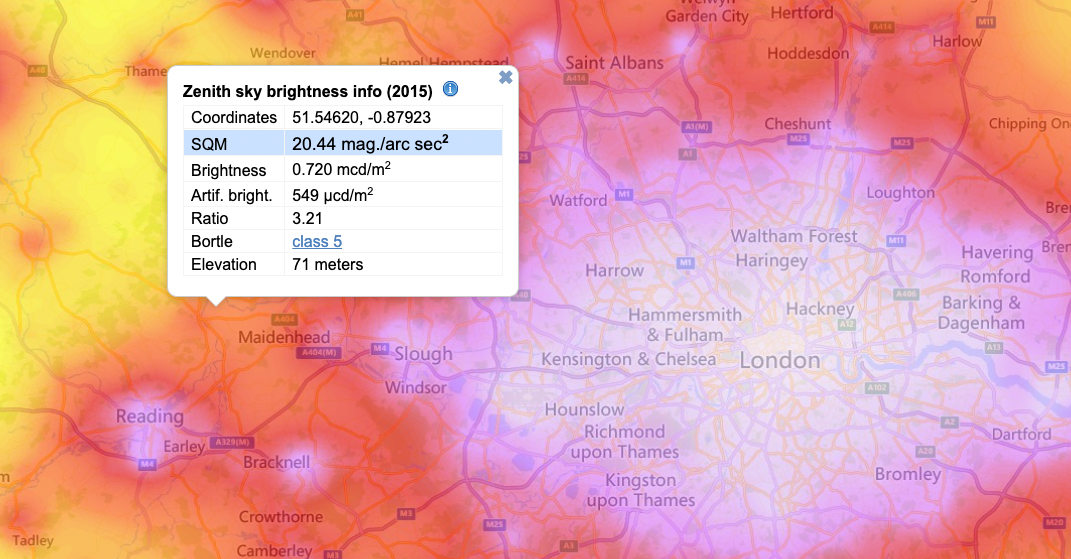Archives
June 2024
Categories
All
|
Back to Blog
Understanding the Bortle Scale12/1/2022 Image credit: Dark Sky Consulting 854 words / 3-minute read The brightness of the night sky at a given location is an important indicator of the health of the nighttime environment. Many factors influence what we see when we look up at night, as we recently wrote about here. Light pollution is only one factor to consider, albeit an important one. Rather than thinking only about brightness, sometimes one hears about night sky "quality". While the ways we characterize the the night sky can be rather technical, we wish for something simple. A convenient shorthand, first described two decades ago, offers such an approach: the Bortle Scale. Devised by amateur John Bortle, the scale is a simple and intuitive way to classify night sky quality. Everyone is familiar with scales that rank this or that over a range of, say, one to ten. The Bortle Scale ranges from one to nine, and it works backward: a better night sky gets a smaller number. The value of sky quality estimates Taking a small step back, why do we care about any of this? Quantitative measurements of sky quality are best, but data are often difficult to get. But it's much easier to get more people out in the field who can make subjective assessments. In turn, researchers can keep tabs on how conditions are changing in different places due to light pollution. We can also use this information to assess how well lighting retrofits are going, or to identify potential new astrotourism sites. But the question of "how dark is the night sky" is more complex than it seems on the surface. Besides artificial skyglow, there are many natural sources of light in the night sky. The contributions of these sources span a large range in brightness, and they vary in time; no two nights at the same location are ever the same. Other means of assessing night sky brightness are often not very consistent, making comparisons difficult. This also complicates quantitative measurements, so we end up relying on long-term statistical distributions that characterize the probability of any particular night having any particular sky quality. A simple approach That's where the Bortle Scale comes in. It aims to reduce some of the complexity of quantitative measurements while retaining the value of simple comparisons between sites. The scale divides night sky quality into nine levels ranging from badly light-polluted city skies to pristine rural skies:
For each level, it lists several distinguishing characteristics that users can look for. With some practice, users can tell the different levels apart with reliability. Because the Bortle Scale levels roughly overlap ranges of other sky quality indicators, it can be predictive. For example, the website lightpollutionmap.info provides an estimate of the Bortle Scale for any location with a click of the mouse. The instance below shows an area on the western outskirts of London, U.K., is a "Bortle 5" site. The Bortle level serve as a first guess of what quantitative measures of sky brightness might show. Of course, the Bortle Scale approach has its own drawbacks. It involves a subjective assessment specific to a particular observer. In that sense, it is "impressionistic" and depends on the conditions of a particular night. It's also sensitive to an observer's experience and visual acuity. The boundaries between the Bortle levels are often "fuzzy", calling for further shades of difference that the system doesn't permit. Yet with further impressions by other observers, the picture can become clearer. A study of citizen science data collected as part of the Globe At Night project supports this idea. Researchers compared thousands of visual night sky brightness estimates to satellite measurements and found good correspondence. They found that visual impressions "depend strongly on artificial skyglow and could be used to track lighting changes worldwide." Power in numbers Despite its limitations, Bortle Scale estimates have distinct value. Over time, variations among observers will even out and a 'typical' sky quality at a site emerges. The numbers can suggest places worthy of more study, and especially of quantitative measurements. Repeated site visits may suggest slow changes in sky quality over time, for better or worse. In particular, the first notion of degrading night skies may be a slide in the Bortle level.
And the Bortle Scale represents a comfortable language for use in talking to the public and elected officials. It can help support dark-sky conservation efforts by making the subject easier to understand. A straightforward rating can even impart a sense of familiarity to those who otherwise know little about light pollution. What is the Bortle Scale number for your location? You can look for it on lightpollutionmap.info, or try making your own estimate using John Bortle's original description. What you discover in the process might surprise you! Need help interpreting your results? Or maybe you want to take the next step and make more rigorous measurements of your site quality? Contact us today for advice.
0 Comments
Read More
Your comment will be posted after it is approved.
Leave a Reply. |
 RSS Feed
RSS Feed


